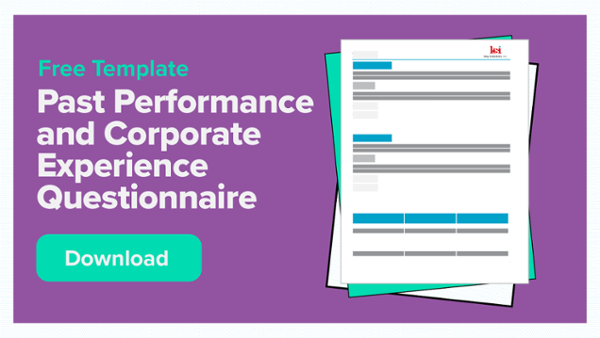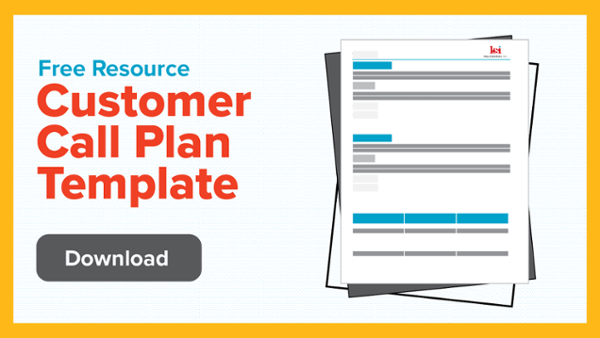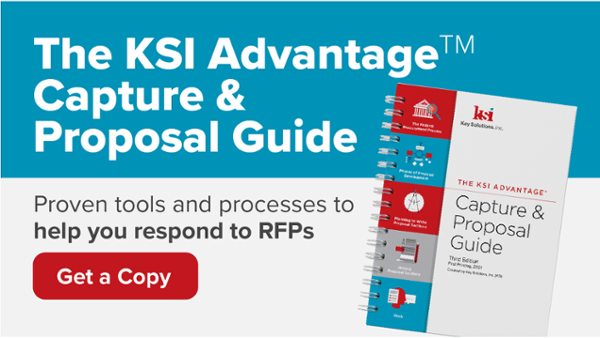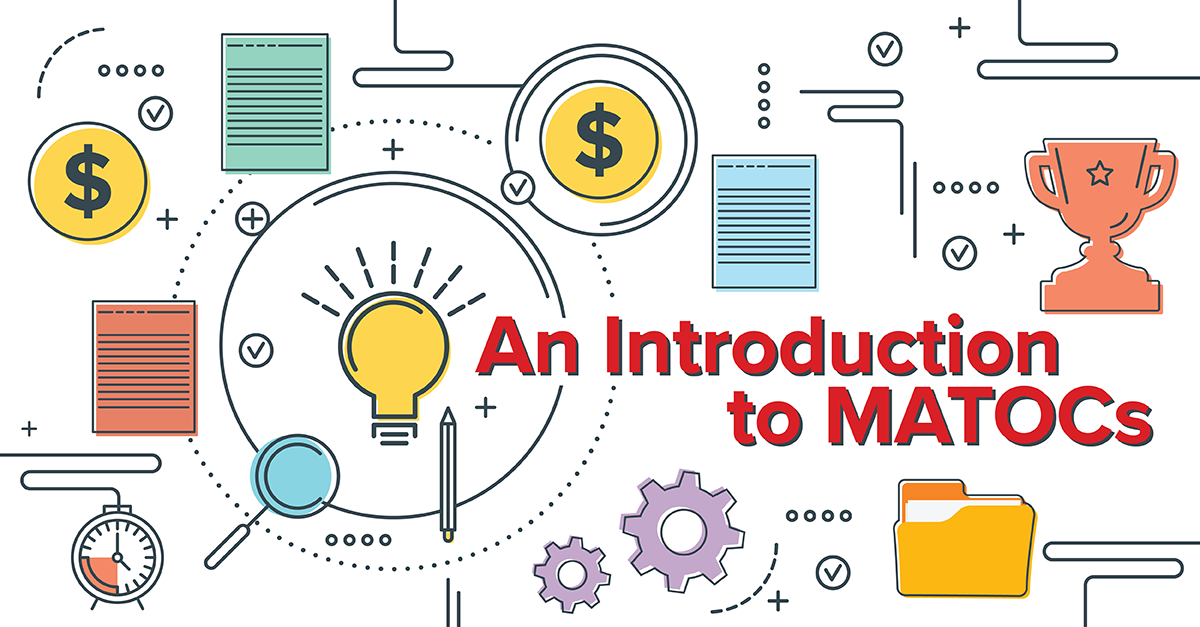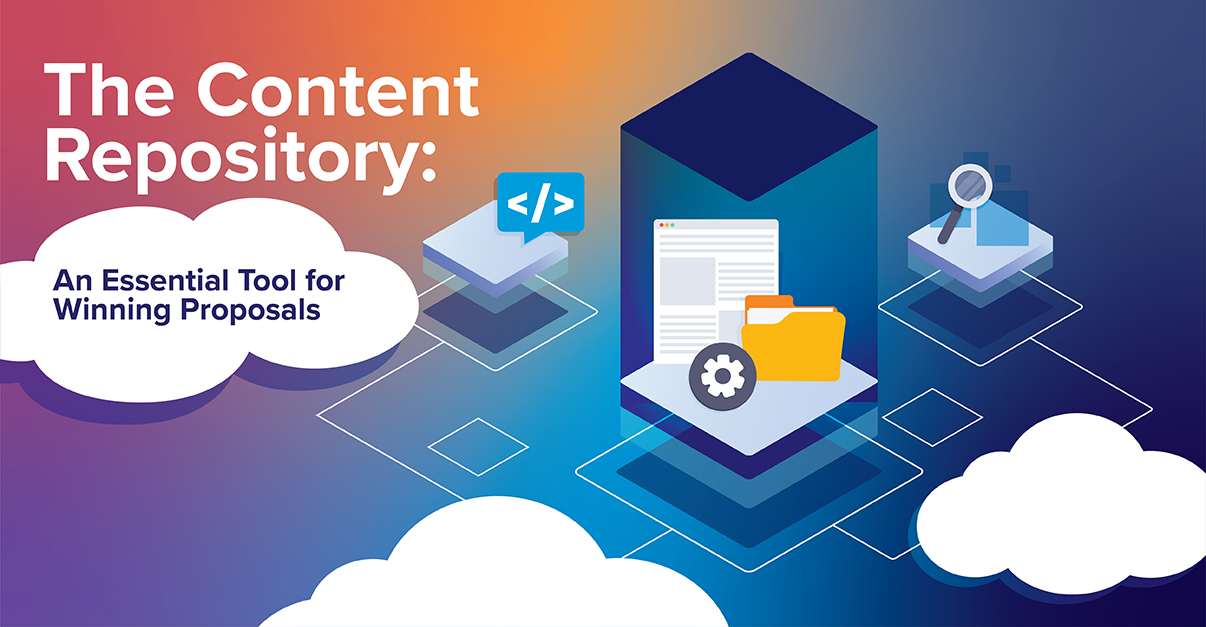
Creating and maintaining a content repository or library of reuse material is a proposal industry best practice, but why is it important? Why should your company or team invest in the development and maintenance of a content repository?
Developing a proposal response is a difficult and often stressful process, especially given the amount of work required within the allotted timeline. Even from an incumbent standpoint, there is barely enough time to respond to a solicitation at the quality level you want.
When developed, organized, and maintained correctly, a repository can save you valuable time within your proposal schedule, reducing the hours spent developing content from scratch or even gleaning content from a previous bid to meet the needs of your current proposal.
A content repository that is up-to-date, easy to use, and easy to navigate is a tremendous help to your proposal development team because they are starting from approved language, information, and data. It ensures the greatest chance of success.
When created and maintained properly, a content repository serves as a vital resource of a competitive, approved response narrative that enables you to develop winning proposals.
In this article, we cover how to create, organize and maintain an effective proposal content library in the following sections:
- Centralized Content Repository
- Repository Organization
- Content Library Types
- Developing Repository Content
- Repository Maintenance
Centralized Content Repository
A centralized content repository is key to ensuring easy access to content and materials for all appropriate individuals involved. The virtual management platform you decide to use is up to you. Be sure to research the various options—SharePoint, Privia, Box, Dropbox, Google Docs, etc.—to ensure the right fit for your company. Also, take into consideration platforms that potentially integrate with your company systems for additional efficiencies.
Repository Organization
Familiarity with the submitted proposal content is certainly helpful when tracking down language for an active bid; however, it can be difficult to remember where you wrote to what months after the deadline. It can be even harder to remember when you supported multiple proposals for months on end. And what happens if you add a new member to your team? These all too common circumstances are where the organization and functionality of your repository come into play.
When organizing your repository, keep in mind the following principles or guidelines:
- Folder Structure: Maintain a consistent folder structure and file labeling or classification for intuitive navigation. Avoid “folder inception”—folders within folders within folders. Too many layers of folders can make it difficult to find the information you are looking for.
- Summaries and Keyword Lists: Consider adding document summaries and keyword lists within the file descriptions or properties. These additional fields create another level of helpfulness when searching your repository for relevant information. These details can help your team surmise the contents of a document without opening individual files.
- Search Feature: It is also important to enable or configure the search feature within the repository to help you or your team easily locate relevant content or information, again without needing to open and read each document.
- Separation of Content in Libraries (Boilerplate vs. Past Proposal Submissions): When organizing your repository, also be sure to separate your boilerplate content library from the past proposal submissions library. The separation of these two types of content helps you and your team maintain clean boilerplate content.
These configurations are time-savers that can feel like a lifesaver when working against tight deadlines.
It is a best practice to maintain a list of boilerplate content used on various proposals. This list not only enables you to track the most successful and competitive content based on awards, but it also helps you locate information that has been tailored for a particular type of contract or a specific proposal (e.g., that focused on training aspects vs. traditional IT services). The list is updated after each submission as part of the “close out” process of a proposal.
Content Library Types
Repository content is broken into two types of libraries: boilerplate and past proposal submissions.
1. Boilerplate is clean, up-to-date, and factually accurate content. This content does not include any customer specifics, such as names, customer entities, or agencies. Boilerplate content covers sections, processes, and approaches that are considered company standard and are applicable or remain the same no matter the proposal effort.
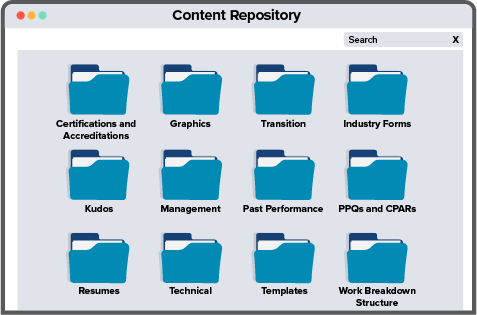
Clean boilerplate documents can also include placeholders, such as [CUSTOMER NAME] or [AGENCY] or [SUBCONTRACTOR]. BY simply executing a “replace all” for each placeholder, boilerplate content is quickly tailored for an active proposal.
For a boilerplate library, consider separating content into the following categories (as seen in the above graphic):
- Certifications and accreditations: both company and key personnel certifications and accreditations, which can serve as features in a proposal
- Documented kudos: testimonials or written appreciation from customers demonstrating your company’s or project personnel’s work on a contract
- Graphics library: process workflows, introduction/overview graphics, and management processes graphics
- Industry-specific forms: pre-populated versions
- Management: standard processes and tools
- Past Performance: write-ups, descriptions, or references of active or recent projects (include pertinent metrics)
- Past Performance Questionnaires (PPQs) and Contractor Performance Assessment Reports (CPARs)
- Resumes: separated into leadership (focused on performance for a company) and technical (focused on performance in a role and on a project) categories
- Technical: standard processes, systems/solution aspects, and tools
- Templates: Resume and Past Performance templates
- Transition: standard transition/implementation language
- Work Breakdown Structure (WBS): standard organization of the team’s work into manageable sections
2. Past proposal submissions are previous proposals your team or company developed and submitted, which are used as additional forms of reference for writers and/or team members developing content for active bids.
Past proposal submissions require more review, tailoring, and editing when repurposing content, which is a time-consuming exercise depending on how relevant the material is to an active proposal. A writer’s familiarity with the material and customer are factors that also help mitigate the time-consuming reuse and tailoring steps. If you are repurposing the content for the same or similar customer, or the writer worked on the previous submission, the ability to reuse the content is easier because the writer will have familiarity with and understanding of the sections.
For a past proposal submissions library, considering organizing bids by the following information:
- Submission year
- Customer/agency
- Project/contract name
- Bidding entity (depending on the size of your organization)
- Win or Loss, as applicable
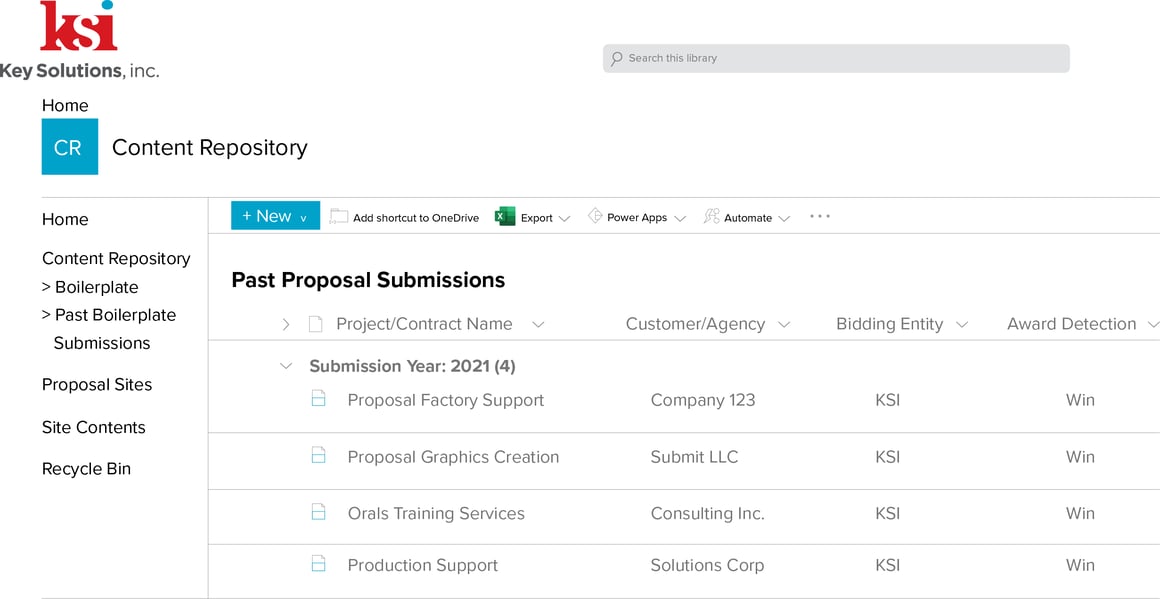 Example of a Past Proposal Submissions Library
Example of a Past Proposal Submissions Library
Within each past proposal submission in your content repository, include the following information:
- Final submission documents, including all attachments or supplemental information
- Request for Proposal (RFP)/solicitation documents, which help evaluate the relevance of the previous proposal to what you are currently working on without what was being responded to
- Feedback from evaluation boards, which help you understand the strengths and weaknesses of the content
Keeping your boilerplate and past proposal submissions libraries separate from one another helps keep content clean and organized. As demonstrated in the example graphic above, the different libraries are categorized and organized based on their content—boilerplate is organized by section or topic, while past proposal submissions are categorized by opportunity information and recency.
Developing Repository Content
The initial content development phase takes a team of individuals and writers to consolidate, sanitize, and distribute content for review and updates.
Depending on the amount of content or backlog, this team can consist of a minimum of two to five individuals. Your team can write, edit, update, and clean boilerplate content between opportunities. If you do not have internal resources to support the development of a content repository or you are working toward an accelerated timeline, consider engaging outside resources or consultants to provide the same support.
Outside resources can focus on the content initiative full time, enabling your team to concentrate on their daily responsibilities. Once the initial content development phase is complete, designate individuals from your internal team to maintain the repository content moving forward.
Boilerplate Content Development
Organization and coordination are vital during boilerplate development. It is important to maintain a content tracking sheet, which lists the content being developed, the team member responsible for the content, the assigned subject matter expert (SME) (if applicable), the estimated return date, as well as content status (e.g., Under Development, Sent to SME, Reviewed, Updated).
Writers or appropriate team members send data calls to the SMEs or operations team for technical input and project-specific details, as well as current data points. Depending on the availability of the SMEs and operations team members, writers may receive better responses and support through meetings or interviews with the SMEs. Once the input from the SMEs has been incorporated, the updated boilerplate content is sent to the appropriate individuals for review. Writers recover the boilerplate review comments and upload the updated version to the appropriate library and folder in the content repository.
Proposal Content Development
The development of content for the past proposal submissions library follows the standard proposal development process. Once a proposal is complete and submitted, the final submission version can be uploaded to the past proposal submissions library and categorized appropriately. As detailed above, be sure to include all solicitation documents associated with the bid. Once released, upload the evaluation board feedback to the associated opportunity folder to help track the performance of your content.
For more information regarding a standard proposal development process, check out this article.
Repository Maintenance
According to Gordan Moore’s law, which is an observation and projection of a historical trend, if you’re not updating your data and competitive intelligence every 18 months, you’re falling behind. His law is used to guide long-term planning and set targets for research and development. Content repository maintenance is a prime example of Moore’s law.
The content in your repository must be properly maintained and regularly updated to remain relevant and enable you to submit competitive proposals.
Based on your chosen repository platform, the available system integrations can support additional efficiencies, including those related to content maintenance. For instance, virtual management sites like SharePoint allow Contract Management Systems to feed tables within the site with the latest high-level project information, such as Points of Contact (POCs), Period of Performance (POP) dates, and current data points. These types of integrations help you keep high-level project information up to date without having to revise it manually in multiple locations or systems.
The integration is also helpful for creating monthly contract reports from a Contract Management System for all the contracts within a set amount of time (e.g., 10 years). This feature allows users to sort the data by customer and contract type to come up with metrics to use in past performance introductions (e.g., Over the last 10 years, we’ve supported [CUSTOMER] on 50+ IT support contracts of similar size, scope, and complexity to [PROJECT NAME] contract).
Repository maintenance is best when performed by a dedicated team, typically proposal team members and/or writers. The maintenance team is comprised of two individuals or more, depending on the size of your organization. The maintenance team members track the information that has been or needs to be updated in the content repository and reach out to the appropriate SMEs or operations team members for assistance updating content.
Boilerplate Maintenance
Repository maintenance is constant. The following content maintenance methods help your team sustain an up-to-date boilerplate library:
- Boilerplate Tracking List: As mentioned above, the boilerplate tracking list is a best practice tool that will help you maintain your boilerplate content. By tracking the exact boilerplate used in each proposal, you will be able to identify correlations between certain content and winning proposals. The tracking list will also help you find less successful boilerplate based on the losses and evaluation feedback or debrief from the customer. The feedback received enables your team to update content accordingly for upcoming proposals.
- Active Proposal Updates: Updates to company standard language or information may be completed throughout the year, which includes changes to boilerplate content during active proposals. It is important to record and track the boilerplate content changed during a proposal so it can be updated in the boilerplate library.
- Annual Review Cycle: Annual reviews of your boilerplate ensure the content aligns with any updates or changes to your company’s standard processes and approaches.
- Lessons Learned: Conducting lessons learned helps introduce updates and identifies the language in need of maintenance to sustain accurate and competitive boilerplate content. Lessons learned occur in two places of the opportunity lifecycle:
-
- After Proposal Submission (Internal Lessons Learned): An internal lesson learned session is a small picture/concentrated viewpoint of the content.
- Post-Award, Post-Debrief (External Lessons Learned): An external customer-led lessons learned is a big picture view of the proposal and content.
Be sure to build questions into the lessons learned to ensure the quality of content using Key Performance Indicators (KPIs). The KPIs are gathered from feedback on Color Team Reviews. If there is an issue with a section, you must determine if the boilerplate content or the customized content is the root of the problem.
Being able to determine the initial point of cause enables you to address potential issues in boilerplate content.
Past Proposal Submissions Maintenance
As your library of past proposal submissions grows, the maintenance team will update the content to reflect the most recent proposals, clearly emphasizing the submissions resulting in contract awards. Older submissions will be archived to help highlight the latest content, giving your team the best competitive advantage.
Depending on the size of your organization and the number of proposals your company submits in a year, your team may decide to archive proposals submitted 5 to 10 years prior. Whatever the cutoff, the designated content repository team members will be responsible for archiving older proposals.
Conclusion
Your content repository is only as strong as the information and effort put into it. A repository is not a one-time exercise, but a living resource of competitive intelligence, content, and information. Assigning a team of select individuals to manage and regularly update the content repository will help ensure the success of the initiative and future proposal submissions.



